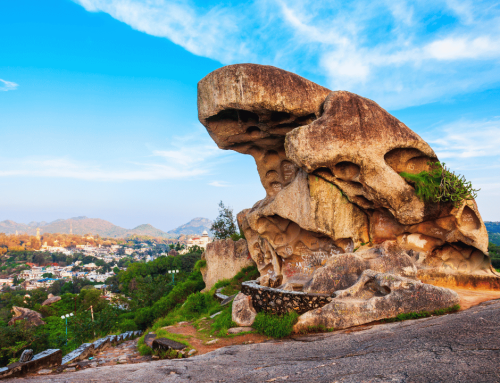Overview and Historical Significance
The Gun House in Mysore, Karnataka, is a prominent colonial-era building constructed in 1910. It served as an ammunition storage facility for the British military stationed in the princely state of Mysore. The structure is located close to the iconic Mysore Palace and the city’s Race Course, making it a key component of the colonial administrative and military network in the region. Architecturally, the Gun House represents a blend of British military design and local influences, featuring high ceilings, arched doorways, and expansive verandahs that reflect the utilitarian yet aesthetic approach of British structures in India.
Above image Gun House Circle, Mysore, Controversial statue: The statue of late Suttur Seer Dr. Sri Shivarathri Rajendra Swamiji at the Gun House Circle near the Palace….…………..
During its active years, the Gun House was strategically significant as it functioned as a depot for arms and ammunition, ensuring the British had a stronghold over the region. Its location near the palace underlined the authority of the British, even as they collaborated with the Wadiyar dynasty that ruled the princely state. Over the decades, it became a symbol of the colonial era and, post-independence, a reminder of the strategic role Mysore played during British rule.
Transformation and Current Usage
After India’s independence, the Gun House ceased its military function and was handed over to the Karnataka state government. Over time, it has undergone multiple phases of adaptive reuse. For several years, it functioned as a restaurant, serving local and international cuisine while preserving its colonial charm. Later, it was briefly used for exhibitions and cultural events. Despite these efforts to keep it relevant, the building struggled to find a permanent purpose.
Today, the Gun House stands as a heritage site, but its role in the city’s cultural and urban landscape remains ambiguous. While heritage activists have emphasized its architectural and historical value, concerns over its maintenance and long-term preservation have persisted. There have been efforts to designate it as a protected heritage structure, but these have been met with limited success due to bureaucratic and funding challenges.
The Statue Controversy: Honoring Nalwadi Krishnaraja Wadiyar IV
In recent years, the Gun House has become the center of a controversy regarding a proposed statue of Nalwadi Krishnaraja Wadiyar IV, a beloved ruler of the Mysore Kingdom who reigned from 1902 to 1940. Known for his progressive reforms and development initiatives, Nalwadi Krishnaraja Wadiyar is revered as the architect of modern Mysore. The proposal to erect his statue near the Gun House aimed to honor his contributions and add to the city’s cultural landscape.
However, the proposal has been met with stiff resistance from heritage conservationists, who argue that installing a statue near the Gun House would compromise the historical integrity of the structure and its surroundings. They believe that modern installations could detract from the building’s colonial character and set a precedent for similar modifications to other heritage sites.
Preservation vs. Commemoration: The Current Status
The statue controversy has triggered a broader debate about balancing heritage preservation with the need to commemorate local history. While some believe that the statue would bring renewed attention to both the Gun House and the legacy of Nalwadi Krishnaraja Wadiyar, others fear it could overshadow the colonial-era architecture and undermine ongoing preservation efforts.
As of now, the proposal has been put on hold, and discussions are ongoing among local authorities, heritage activists, and cultural leaders. The Mysore Urban Development Authority (MUDA) and the Department of Archaeology have been involved in evaluating alternative sites for the statue to ensure both the Gun House and the memory of the revered ruler are appropriately honored.
Future Prospects for the Gun House
The future of the Gun House hinges on finding a solution that respects its historical significance while accommodating the city’s evolving identity. Heritage activists have called for a comprehensive restoration plan that would conserve the structure and possibly convert it into a museum or cultural center highlighting Mysore’s colonial and royal past. This approach, they argue, would ensure that the Gun House remains a focal point of Mysore’s heritage narrative, rather than a backdrop for modern commemorations.
For now, the Gun House stands as a reminder of Mysore’s complex colonial history, awaiting a consensus that will secure its place in the city’s cultural heritage for generations to come.

